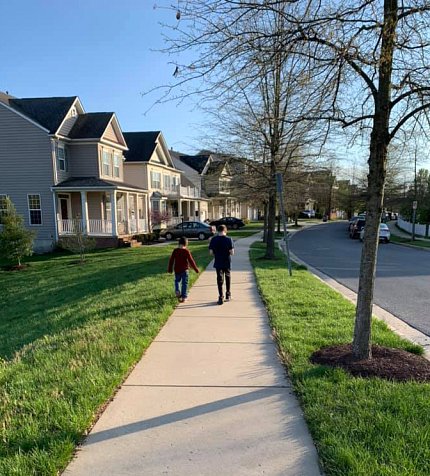The Plummers Find Fulfillment in Fostering Children

“Dada!” exclaimed the 2-year-old, and the 1-year-old echoed, babbling as they bounced on their daddy’s lap during his phone interview. The two little ones are among the foster children currently living with Jason Plummer, an OD supervisory administrative officer, and his husband Chris, who recently left his job as a project specialist at FDA to become a stay-at-home dad.
Starting a family can be an especially cumbersome process for two married men. Friends had suggested adopting a baby from abroad, but the Plummers wanted to look locally, knowing that many children here in Montgomery County needed help.
There are about 450 children in foster care at any given time in the county and 125 active foster parent homes. Many families, like the Plummers, foster several children at a time, as new kids enter the system weekly.
Three years ago, when the Plummers contacted Montgomery County’s department of health and human services to inquire about becoming foster parents, they received a huge packet of paperwork. The recruiter told them it would probably take a few months to fill everything out. They returned all the papers in 2 weeks.
“We were very much energized and ready to do this,” recalled Jason.
In October 2017, after a lengthy training class and 3 home studies, the Plummers became licensed to house 3 children. Since then, they’ve fostered 23 children ranging in age from 3 days to 20 years old and who have lived with them for anywhere from a day to 14 months.

Every child in foster care enters the system for traumatic reasons—from neglect and abuse to mental health problems. Jason says his psychology degree helps him relate to his foster children on a different level.
“You have to work with them and understand a little bit about their background,” he said, “and you have to have a lot of patience.”
In December, the Plummers moved to a larger house and within weeks became licensed to take in 6 children at a time, the maximum allowed in the county. Currently, they have 4 foster children, ages 1, 2, 5 and 13.
Now, they’re also taking emergency placements during the Covid-19 pandemic. Shelter-in-place orders do not apply to the protection of children, until they arrive in a safe foster environment. Two children recently arrived for a few days, so for a weekend the Plummers had 6 kids plus a 20-year-old, no longer in foster care, who came home from college, all sheltering in place together.
Every night, Jason, Chris and their foster children sit at the dinner table until everyone is done eating. Sometimes, a kid gets frustrated sitting there for so long, said Jason, but they all come to appreciate that time together.
“The most rewarding part of [being a foster parent] is sitting on a couch with all the kids, watching The Lion King, and everybody’s all snuggled up on each other,” he said. “Those are the moments where we say this is what it’s all about. We’re creating a family and an environment that these kids have never had before.”
The hardest part, though, is the unknown. The situation can change at a moment’s notice. A foster parent might receive word a child is going back to a biological family member and suddenly the kid leaves that day.

“It’s hard, even if the kid is with us for only a few weeks,” said Jason. “We get attached very quickly.”
The Plummers once fostered a child for about 3 weeks. About 6 months later, the 13-year-old girl texted them just to check in, and thanked them for taking care of her during her time of need.
“That means we did something to have an impact on this girl and I know that’s a lifelong experience she’ll never forget,” said Jason. “Clearly she looked back on her time with us on a positive note. That’s why I do this.”
Before a 16-year-old boy arrived to stay with them, the social worker warned the boy was angry and probably would barely talk to them. Within a couple hours of his arrival, Jason said, the two had already developed a tight bond. They talked about everything, he said, and they’re still friends on Snapchat.

“My philosophy is: These kids can come here for one day or one year, and they will have a completely different experience than they’ve had in their lives,” Jason said. “They will see what a relatively normal functioning family is supposed to be like.”
Jason, who also has a 26-year-old biological son, says being a foster parent is endlessly rewarding. “I think I get more out of it than the kids do sometimes. Watching Baby J go from 3 days old to now walking around and experiencing everything about life is just absolutely amazing.”
In February, the Maryland court system changed Baby J’s permanency plan from reunification to adoption by other than kin, paving the way for the Plummers to become the baby’s legal parents. They are in the process of filing to adopt him.
